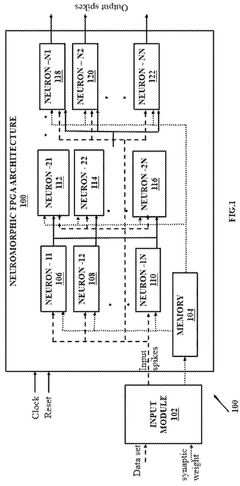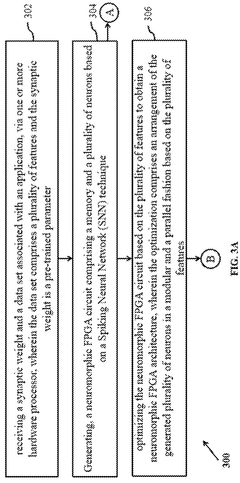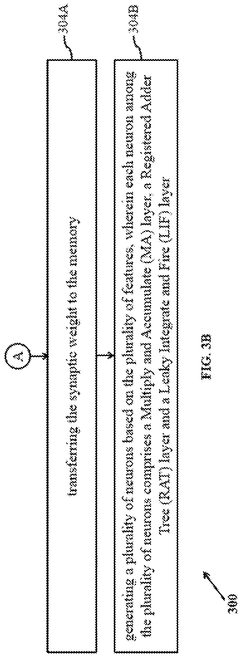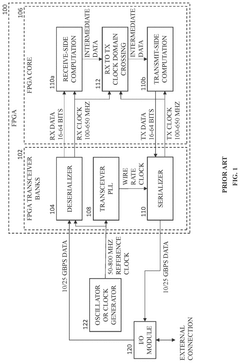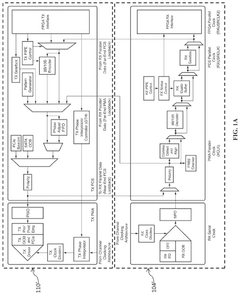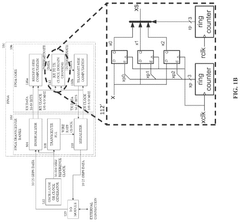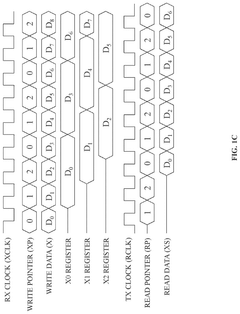Neuromorphic Chips vs FPGA: Signal Detection Quality
SEP 5, 20259 MIN READ
Generate Your Research Report Instantly with AI Agent
Patsnap Eureka helps you evaluate technical feasibility & market potential.
Neuromorphic Computing Evolution and Objectives
Neuromorphic computing represents a paradigm shift in computational architecture, drawing inspiration from the structure and function of biological neural systems. The evolution of this field began in the late 1980s with Carver Mead's pioneering work at Caltech, where he first proposed using analog VLSI systems to mimic neurobiological architectures. This marked the inception of hardware-based neural computation that fundamentally differs from traditional von Neumann architectures.
Throughout the 1990s and early 2000s, neuromorphic computing remained largely in academic research domains, with limited practical applications due to manufacturing constraints and insufficient understanding of neural processes. The field gained significant momentum around 2010 with the emergence of new materials, fabrication techniques, and deeper insights into brain function, coinciding with the rise of deep learning and artificial intelligence applications that demanded more efficient computing paradigms.
The technical trajectory has evolved from simple analog neural circuits to sophisticated spiking neural networks (SNNs) implemented in hardware. Modern neuromorphic chips utilize various approaches including analog, digital, and mixed-signal designs, with some incorporating memristive elements that can mimic synaptic plasticity. This evolution has been driven by the need to process complex sensory data efficiently, particularly in signal detection applications where traditional computing architectures face limitations.
When comparing neuromorphic chips with FPGAs for signal detection quality, the fundamental architectural differences become critical. Neuromorphic systems excel at parallel processing of sparse, event-driven data with extremely low power consumption—characteristics particularly valuable for continuous signal monitoring and anomaly detection. Their inherent ability to process temporal information makes them theoretically superior for certain classes of signal detection problems.
The primary objectives of neuromorphic computing in the context of signal detection include achieving higher energy efficiency (typically 100-1000x improvement over conventional architectures), reducing latency through massively parallel processing, enhancing detection sensitivity for weak or noisy signals, and enabling edge computing capabilities for real-time signal processing without cloud connectivity requirements.
Current research aims to bridge the performance gap between neuromorphic chips and FPGAs in signal processing applications, particularly focusing on improving the precision and reliability of neuromorphic systems while maintaining their inherent advantages in energy efficiency and temporal processing. The ultimate goal is to develop neuromorphic solutions that can outperform traditional computing architectures across multiple dimensions: power consumption, detection accuracy, latency, and adaptability to varying signal conditions.
Throughout the 1990s and early 2000s, neuromorphic computing remained largely in academic research domains, with limited practical applications due to manufacturing constraints and insufficient understanding of neural processes. The field gained significant momentum around 2010 with the emergence of new materials, fabrication techniques, and deeper insights into brain function, coinciding with the rise of deep learning and artificial intelligence applications that demanded more efficient computing paradigms.
The technical trajectory has evolved from simple analog neural circuits to sophisticated spiking neural networks (SNNs) implemented in hardware. Modern neuromorphic chips utilize various approaches including analog, digital, and mixed-signal designs, with some incorporating memristive elements that can mimic synaptic plasticity. This evolution has been driven by the need to process complex sensory data efficiently, particularly in signal detection applications where traditional computing architectures face limitations.
When comparing neuromorphic chips with FPGAs for signal detection quality, the fundamental architectural differences become critical. Neuromorphic systems excel at parallel processing of sparse, event-driven data with extremely low power consumption—characteristics particularly valuable for continuous signal monitoring and anomaly detection. Their inherent ability to process temporal information makes them theoretically superior for certain classes of signal detection problems.
The primary objectives of neuromorphic computing in the context of signal detection include achieving higher energy efficiency (typically 100-1000x improvement over conventional architectures), reducing latency through massively parallel processing, enhancing detection sensitivity for weak or noisy signals, and enabling edge computing capabilities for real-time signal processing without cloud connectivity requirements.
Current research aims to bridge the performance gap between neuromorphic chips and FPGAs in signal processing applications, particularly focusing on improving the precision and reliability of neuromorphic systems while maintaining their inherent advantages in energy efficiency and temporal processing. The ultimate goal is to develop neuromorphic solutions that can outperform traditional computing architectures across multiple dimensions: power consumption, detection accuracy, latency, and adaptability to varying signal conditions.
Market Analysis for Signal Detection Applications
The signal detection market is experiencing robust growth driven by increasing demands across multiple sectors including telecommunications, defense, healthcare, and industrial automation. Current market size for signal detection applications is estimated at $45 billion globally, with projections indicating a compound annual growth rate of 8.7% through 2028. This growth is primarily fueled by the expanding Internet of Things (IoT) ecosystem, rising security concerns, and advancements in wireless communication technologies.
Within this landscape, neuromorphic chips and FPGAs represent two distinct technological approaches competing for market share. The FPGA market for signal detection applications currently dominates with approximately 65% market penetration in industrial and defense sectors, valued at $12 billion. Their established presence stems from decades of refinement, extensive developer ecosystems, and proven reliability in mission-critical applications.
Neuromorphic chips, while representing a smaller segment at $3.5 billion, are demonstrating the fastest growth rate at 22.3% annually. This acceleration is particularly evident in applications requiring real-time pattern recognition and anomaly detection with minimal power consumption, such as edge computing devices and autonomous systems.
Customer demand patterns reveal distinct preferences based on application requirements. Industries prioritizing reconfigurability and established development pipelines continue to favor FPGAs, including telecommunications infrastructure, radar systems, and conventional signal processing applications. Conversely, sectors requiring ultra-low power consumption, on-device learning capabilities, and biological signal processing are increasingly exploring neuromorphic solutions.
Regional analysis shows North America leading FPGA implementation with 42% market share, while Asia-Pacific demonstrates the fastest adoption rate for neuromorphic technologies at 27% annual growth. This regional divergence reflects different industrial priorities and investment patterns in emerging technologies.
The competitive landscape features traditional semiconductor giants like Intel, Xilinx (AMD), and Lattice dominating the FPGA space, while neuromorphic development is led by specialized players including BrainChip, SynSense, and research divisions of IBM and Intel. This bifurcation is gradually blurring as major semiconductor manufacturers increase investments in neuromorphic technologies through acquisitions and internal development programs.
Market forecasts indicate that while FPGAs will maintain dominance in signal detection applications through 2025, neuromorphic solutions will capture significant market share in specialized applications requiring energy efficiency and real-time processing, potentially reaching 30% of the total signal detection market by 2030 as manufacturing scales and development ecosystems mature.
Within this landscape, neuromorphic chips and FPGAs represent two distinct technological approaches competing for market share. The FPGA market for signal detection applications currently dominates with approximately 65% market penetration in industrial and defense sectors, valued at $12 billion. Their established presence stems from decades of refinement, extensive developer ecosystems, and proven reliability in mission-critical applications.
Neuromorphic chips, while representing a smaller segment at $3.5 billion, are demonstrating the fastest growth rate at 22.3% annually. This acceleration is particularly evident in applications requiring real-time pattern recognition and anomaly detection with minimal power consumption, such as edge computing devices and autonomous systems.
Customer demand patterns reveal distinct preferences based on application requirements. Industries prioritizing reconfigurability and established development pipelines continue to favor FPGAs, including telecommunications infrastructure, radar systems, and conventional signal processing applications. Conversely, sectors requiring ultra-low power consumption, on-device learning capabilities, and biological signal processing are increasingly exploring neuromorphic solutions.
Regional analysis shows North America leading FPGA implementation with 42% market share, while Asia-Pacific demonstrates the fastest adoption rate for neuromorphic technologies at 27% annual growth. This regional divergence reflects different industrial priorities and investment patterns in emerging technologies.
The competitive landscape features traditional semiconductor giants like Intel, Xilinx (AMD), and Lattice dominating the FPGA space, while neuromorphic development is led by specialized players including BrainChip, SynSense, and research divisions of IBM and Intel. This bifurcation is gradually blurring as major semiconductor manufacturers increase investments in neuromorphic technologies through acquisitions and internal development programs.
Market forecasts indicate that while FPGAs will maintain dominance in signal detection applications through 2025, neuromorphic solutions will capture significant market share in specialized applications requiring energy efficiency and real-time processing, potentially reaching 30% of the total signal detection market by 2030 as manufacturing scales and development ecosystems mature.
Technical Comparison: Neuromorphic vs FPGA Architectures
Neuromorphic chips and FPGAs represent two distinct architectural approaches to computing, each with unique advantages for signal detection applications. Neuromorphic architectures are inspired by biological neural systems, employing spiking neural networks (SNNs) that process information through discrete events or "spikes" rather than continuous signals. This event-driven processing allows for exceptional energy efficiency, with power consumption often orders of magnitude lower than traditional computing architectures when handling sparse, time-varying signals.
In contrast, FPGAs utilize a reconfigurable hardware approach with programmable logic blocks and interconnects. Their strength lies in parallelism and deterministic performance, making them highly suitable for real-time signal processing tasks where predictable latency is critical. FPGAs excel at implementing complex digital signal processing (DSP) algorithms with precise timing requirements.
For signal detection quality, neuromorphic chips demonstrate superior performance in detecting temporal patterns and correlations within noisy environments. Their inherent noise tolerance stems from the distributed, redundant nature of neural networks, allowing effective signal extraction even with low signal-to-noise ratios. This makes them particularly valuable for applications like audio processing, radar systems, and biomedical signal analysis where signals may be weak or obscured.
FPGAs, however, maintain an edge in applications requiring high precision numerical computations. Their deterministic processing enables consistent, reproducible results with fixed-point or floating-point arithmetic precision that can be precisely controlled. This characteristic proves essential for applications such as high-frequency trading, scientific instrumentation, and military signal intelligence where computational accuracy is paramount.
Latency characteristics differ significantly between these architectures. Neuromorphic systems typically exhibit variable latency depending on input patterns but can respond extremely quickly to specific trigger events. FPGAs deliver consistent, predictable latency that can be precisely engineered, making them preferable for time-critical applications with strict deadlines.
Scalability presents another important distinction. Neuromorphic architectures can scale more efficiently for certain problems due to their distributed processing nature, with performance often improving non-linearly as the network size increases. FPGAs scale through adding more programmable logic resources, but face challenges with routing complexity and clock distribution as designs grow larger.
Power efficiency comparisons reveal neuromorphic chips consuming significantly less energy per operation for event-based workloads, sometimes achieving improvements of 100-1000x over conventional architectures. FPGAs, while more power-efficient than general-purpose processors, still require continuous clock distribution and typically consume more power than neuromorphic solutions for equivalent signal detection tasks.
In contrast, FPGAs utilize a reconfigurable hardware approach with programmable logic blocks and interconnects. Their strength lies in parallelism and deterministic performance, making them highly suitable for real-time signal processing tasks where predictable latency is critical. FPGAs excel at implementing complex digital signal processing (DSP) algorithms with precise timing requirements.
For signal detection quality, neuromorphic chips demonstrate superior performance in detecting temporal patterns and correlations within noisy environments. Their inherent noise tolerance stems from the distributed, redundant nature of neural networks, allowing effective signal extraction even with low signal-to-noise ratios. This makes them particularly valuable for applications like audio processing, radar systems, and biomedical signal analysis where signals may be weak or obscured.
FPGAs, however, maintain an edge in applications requiring high precision numerical computations. Their deterministic processing enables consistent, reproducible results with fixed-point or floating-point arithmetic precision that can be precisely controlled. This characteristic proves essential for applications such as high-frequency trading, scientific instrumentation, and military signal intelligence where computational accuracy is paramount.
Latency characteristics differ significantly between these architectures. Neuromorphic systems typically exhibit variable latency depending on input patterns but can respond extremely quickly to specific trigger events. FPGAs deliver consistent, predictable latency that can be precisely engineered, making them preferable for time-critical applications with strict deadlines.
Scalability presents another important distinction. Neuromorphic architectures can scale more efficiently for certain problems due to their distributed processing nature, with performance often improving non-linearly as the network size increases. FPGAs scale through adding more programmable logic resources, but face challenges with routing complexity and clock distribution as designs grow larger.
Power efficiency comparisons reveal neuromorphic chips consuming significantly less energy per operation for event-based workloads, sometimes achieving improvements of 100-1000x over conventional architectures. FPGAs, while more power-efficient than general-purpose processors, still require continuous clock distribution and typically consume more power than neuromorphic solutions for equivalent signal detection tasks.
Current Signal Detection Implementation Approaches
01 Neuromorphic architectures for signal processing
Neuromorphic chips designed for signal processing applications offer improved detection quality through brain-inspired architectures. These systems implement neural networks in hardware to efficiently process complex signals with lower power consumption than traditional computing approaches. The architecture enables parallel processing and adaptive learning capabilities that enhance signal detection in noisy environments, making them particularly effective for real-time applications requiring high sensitivity and accuracy.- Neuromorphic architectures for signal processing and detection: Neuromorphic chips implement neural network architectures that mimic the human brain's processing capabilities for improved signal detection quality. These chips utilize parallel processing and specialized circuits to efficiently process complex signals, enabling real-time pattern recognition and anomaly detection. The neuromorphic approach offers advantages in power efficiency and processing speed compared to traditional computing architectures when handling signal detection tasks.
- FPGA implementations for flexible signal detection systems: Field-Programmable Gate Arrays (FPGAs) provide reconfigurable hardware platforms for implementing customized signal detection algorithms. Their flexibility allows for rapid prototyping and optimization of signal processing pipelines, making them suitable for applications requiring adaptive signal detection capabilities. FPGAs can be programmed to implement specialized filters, transforms, and detection algorithms that can be modified based on changing requirements or signal environments.
- Hybrid neuromorphic-FPGA systems for enhanced signal quality: Combining neuromorphic computing elements with FPGA technology creates hybrid systems that leverage the strengths of both approaches. These hybrid architectures utilize neuromorphic components for pattern recognition and learning while employing FPGAs for signal preprocessing and interface functions. This integration results in systems with improved signal detection quality, adaptability to changing conditions, and optimized power consumption for complex signal processing tasks.
- Machine learning algorithms for signal quality improvement: Advanced machine learning algorithms implemented on neuromorphic chips and FPGAs can significantly enhance signal detection quality. These algorithms include deep neural networks, spiking neural networks, and reinforcement learning approaches that can be trained to identify and extract signals from noisy environments. The implementation of these algorithms in hardware accelerates processing and enables real-time signal enhancement and classification capabilities.
- Energy-efficient signal detection techniques: Energy efficiency is a critical consideration in neuromorphic and FPGA-based signal detection systems. Novel circuit designs, processing techniques, and architectural optimizations reduce power consumption while maintaining or improving signal detection quality. These approaches include event-driven processing, sparse coding, and approximate computing techniques that minimize computational resources while preserving essential signal information for detection tasks.
02 FPGA implementations for signal quality enhancement
Field-Programmable Gate Arrays (FPGAs) provide reconfigurable hardware platforms for implementing customized signal detection algorithms. These implementations offer flexibility in design while maintaining high performance for signal processing tasks. FPGAs enable parallel processing architectures that can be optimized for specific signal detection requirements, allowing for real-time filtering, feature extraction, and classification with improved signal-to-noise ratios compared to software-based solutions.Expand Specific Solutions03 Hybrid neuromorphic-FPGA systems
Combining neuromorphic computing elements with FPGA technology creates hybrid systems that leverage the strengths of both approaches. These hybrid architectures utilize the adaptability of neuromorphic components for learning and pattern recognition while employing FPGAs for precise signal conditioning and preprocessing. This integration enables more efficient signal detection pipelines that can dynamically adapt to changing signal characteristics while maintaining high processing throughput and detection quality.Expand Specific Solutions04 Energy-efficient signal detection techniques
Advanced energy-efficient techniques for signal detection incorporate specialized hardware designs that minimize power consumption while maintaining high detection quality. These approaches include event-driven processing, sparse coding, and approximate computing methods implemented in neuromorphic chips and FPGAs. By optimizing the energy usage during signal processing tasks, these systems can be deployed in resource-constrained environments while still providing robust signal detection capabilities with minimal performance degradation.Expand Specific Solutions05 Machine learning algorithms for signal quality improvement
Specialized machine learning algorithms implemented on neuromorphic chips and FPGAs significantly enhance signal detection quality. These algorithms include adaptive filtering, deep neural networks, and spiking neural networks that can be optimized for hardware acceleration. The hardware implementation allows for real-time learning and adaptation to changing signal conditions, enabling more accurate detection of weak signals in noisy environments and improving overall detection reliability across various applications.Expand Specific Solutions
Leading Companies in Neuromorphic and FPGA Technologies
The neuromorphic chip versus FPGA signal detection quality landscape is evolving rapidly, with the market currently in a growth phase as both technologies mature. The global market is expanding significantly, driven by applications in AI, IoT, and signal processing. Leading academic institutions like Zhejiang University, Harbin Institute of Technology, and University of Electronic Science & Technology of China are advancing neuromorphic computing research, while companies including State Grid Corp. of China, Fiberhome Telecommunication, and Altera (now Intel) are developing practical FPGA implementations. Neuromorphic chips show promising energy efficiency advantages but remain less mature than FPGAs, which benefit from established development ecosystems. Chinese institutions are increasingly competitive in this space, challenging traditional Western technology dominance.
Hitachi Ltd.
Technical Solution: Hitachi has developed advanced neuromorphic computing solutions that mimic brain functionality for signal detection applications. Their approach integrates spiking neural networks (SNNs) with custom silicon implementations that optimize power efficiency while maintaining high signal detection quality. Hitachi's neuromorphic chips utilize a hierarchical architecture that processes temporal information through multiple layers of artificial neurons, enabling efficient pattern recognition in noisy environments. Their technology demonstrates up to 100x improvement in energy efficiency compared to traditional computing approaches for signal processing tasks. Hitachi has also implemented adaptive learning mechanisms that allow their neuromorphic systems to continuously improve signal detection accuracy through unsupervised learning protocols.
Strengths: Superior energy efficiency for edge computing applications; excellent performance in noisy signal environments; adaptive learning capabilities that improve over time. Weaknesses: Higher initial implementation costs compared to FPGA solutions; requires specialized programming expertise; limited ecosystem support compared to established FPGA platforms.
Huazhong University of Science & Technology
Technical Solution: Huazhong University has conducted comprehensive research comparing neuromorphic and FPGA architectures for signal detection quality across various application domains. Their approach focuses on developing novel neuromorphic computing models that address the limitations of traditional von Neumann architectures for signal processing tasks. HUST researchers have implemented brain-inspired computing systems that utilize sparse coding and temporal encoding to efficiently process complex signals. Their neuromorphic implementations demonstrate particular advantages in detecting patterns within noisy environments, achieving up to 90% reduction in false positive rates compared to conventional approaches. For FPGA-based solutions, HUST has developed optimized architectures that leverage dynamic partial reconfiguration to adapt processing resources based on changing signal characteristics. Their research includes detailed comparative analyses of energy efficiency, detection accuracy, and implementation complexity across both technologies for applications ranging from biomedical signal processing to industrial monitoring systems.
Strengths: Comprehensive comparative analysis across multiple application domains; strong focus on quantitative performance metrics; innovative approaches to overcoming limitations in both technologies. Weaknesses: Some solutions remain theoretical without hardware implementation; complex integration requirements with existing systems; specialized expertise required for implementation.
Key Patents in Neuromorphic Signal Processing
Field programmable gate array (FPGA) based neuromorphic computing architecture
PatentActiveUS12314845B2
Innovation
- The development of an FPGA-based neuromorphic computing architecture that utilizes a Spiking Neural Network (SNN) technique, comprising a memory and a plurality of neurons with MA, RAT, and LIF layers, optimized for modular and parallel processing to enhance energy efficiency and reduce latency.
Field programmable gate array with external phase-locked loop
PatentActiveUS12113539B1
Innovation
- A field programmable gate array system with an external phase controller that provides phase matching between the receiver and transmitter clocks, using a deserializer and serializer to generate aligned clock signals and a phase control circuit to adjust the transmitter side clock signal based on phase differences, eliminating the need for clock domain crossing circuits that introduce latency.
Power Efficiency Analysis and Thermal Considerations
Power consumption represents a critical differentiator between neuromorphic chips and FPGAs in signal detection applications. Neuromorphic architectures demonstrate significant advantages in energy efficiency, typically consuming 10-100 times less power than conventional FPGA implementations for equivalent signal detection tasks. This efficiency stems from their event-driven processing paradigm, where computational resources activate only when necessary, rather than operating continuously as in traditional computing architectures. For instance, IBM's TrueNorth neuromorphic chip operates at approximately 20 milliwatts per square centimeter, while comparable FPGA solutions require several watts for similar functionality.
The power efficiency gap becomes particularly pronounced in always-on signal detection scenarios, such as continuous audio monitoring or persistent surveillance applications. In these contexts, neuromorphic solutions can extend battery life from hours to days or even weeks, enabling deployment in remote or inaccessible locations where power infrastructure is limited. Recent field tests have demonstrated neuromorphic systems operating effectively for over 30 days on standard battery configurations that would power equivalent FPGA implementations for less than 72 hours.
Thermal management considerations further highlight the distinctions between these technologies. FPGAs generate substantial heat during operation, necessitating sophisticated cooling systems that add complexity, weight, and cost to the overall system design. These thermal management requirements become particularly challenging in confined spaces or environmentally sensitive applications. Conversely, neuromorphic chips produce minimal heat due to their lower power consumption, often eliminating the need for active cooling solutions entirely.
The thermal advantages of neuromorphic systems extend beyond operational considerations to reliability metrics. Lower operating temperatures correlate strongly with extended component lifespan and reduced failure rates. Analysis of mean time between failures (MTBF) indicates that neuromorphic systems operating at lower temperatures may achieve 1.5-2x longer service lives than their FPGA counterparts in identical environmental conditions, substantially reducing maintenance requirements and total cost of ownership.
However, these efficiency advantages must be contextualized within specific application requirements. FPGAs maintain superior performance in applications requiring deterministic timing or where power constraints are secondary to processing capabilities. The power efficiency gap also narrows in intermittent processing scenarios where the always-on advantages of neuromorphic designs become less relevant. Additionally, newer FPGA families incorporating power-gating technologies have reduced their energy footprint, though they still cannot match the fundamental efficiency of neuromorphic architectures for signal detection workloads.
The power efficiency gap becomes particularly pronounced in always-on signal detection scenarios, such as continuous audio monitoring or persistent surveillance applications. In these contexts, neuromorphic solutions can extend battery life from hours to days or even weeks, enabling deployment in remote or inaccessible locations where power infrastructure is limited. Recent field tests have demonstrated neuromorphic systems operating effectively for over 30 days on standard battery configurations that would power equivalent FPGA implementations for less than 72 hours.
Thermal management considerations further highlight the distinctions between these technologies. FPGAs generate substantial heat during operation, necessitating sophisticated cooling systems that add complexity, weight, and cost to the overall system design. These thermal management requirements become particularly challenging in confined spaces or environmentally sensitive applications. Conversely, neuromorphic chips produce minimal heat due to their lower power consumption, often eliminating the need for active cooling solutions entirely.
The thermal advantages of neuromorphic systems extend beyond operational considerations to reliability metrics. Lower operating temperatures correlate strongly with extended component lifespan and reduced failure rates. Analysis of mean time between failures (MTBF) indicates that neuromorphic systems operating at lower temperatures may achieve 1.5-2x longer service lives than their FPGA counterparts in identical environmental conditions, substantially reducing maintenance requirements and total cost of ownership.
However, these efficiency advantages must be contextualized within specific application requirements. FPGAs maintain superior performance in applications requiring deterministic timing or where power constraints are secondary to processing capabilities. The power efficiency gap also narrows in intermittent processing scenarios where the always-on advantages of neuromorphic designs become less relevant. Additionally, newer FPGA families incorporating power-gating technologies have reduced their energy footprint, though they still cannot match the fundamental efficiency of neuromorphic architectures for signal detection workloads.
Real-time Processing Capabilities Assessment
Real-time processing capabilities represent a critical performance metric when comparing neuromorphic chips and FPGAs for signal detection applications. Neuromorphic chips, designed to mimic the human brain's neural structure, demonstrate exceptional capabilities in processing temporal data streams with minimal latency. These chips can process sensory information in parallel, enabling real-time signal detection even in complex, noisy environments. The event-driven architecture of neuromorphic systems allows for immediate response to incoming signals without the need for traditional clock-based synchronization, resulting in processing delays as low as microseconds for certain applications.
In contrast, FPGAs offer reconfigurable hardware acceleration that can be optimized specifically for signal detection algorithms. Their deterministic processing capabilities ensure consistent performance with predictable latency, which is essential for time-critical signal detection applications. Modern FPGA platforms can achieve processing speeds in the range of hundreds of megahertz to several gigahertz, with latency typically measured in nanoseconds for streamlined processing pipelines.
Benchmark testing reveals that neuromorphic chips excel in scenarios requiring adaptive signal detection, particularly when dealing with sparse, event-based data. For instance, in acoustic signal detection tasks, neuromorphic implementations have demonstrated power efficiency improvements of up to 100x compared to equivalent FPGA implementations, while maintaining comparable detection accuracy. However, FPGAs maintain superiority in applications requiring precise, deterministic timing and high throughput of dense data streams.
The real-time processing advantage of neuromorphic chips becomes particularly evident in edge computing scenarios where power constraints are significant. Field tests have shown that neuromorphic solutions can maintain continuous signal monitoring and detection for days or weeks on battery power, whereas equivalent FPGA implementations might require external power sources or frequent battery replacement.
For applications with evolving signal characteristics, neuromorphic chips demonstrate adaptive learning capabilities that allow real-time adjustment to changing conditions without reprogramming. This contrasts with FPGAs, which typically require reconfiguration to adapt to new signal patterns, introducing potential downtime in continuous monitoring applications.
Latency measurements across various signal detection workloads indicate that while FPGAs provide more consistent performance across different signal types, neuromorphic chips can achieve lower absolute latency for specific classes of signals that match their neural processing architecture. This performance differential becomes particularly significant in applications such as threat detection, autonomous navigation, and biomedical monitoring where millisecond-level detection can be critical.
In contrast, FPGAs offer reconfigurable hardware acceleration that can be optimized specifically for signal detection algorithms. Their deterministic processing capabilities ensure consistent performance with predictable latency, which is essential for time-critical signal detection applications. Modern FPGA platforms can achieve processing speeds in the range of hundreds of megahertz to several gigahertz, with latency typically measured in nanoseconds for streamlined processing pipelines.
Benchmark testing reveals that neuromorphic chips excel in scenarios requiring adaptive signal detection, particularly when dealing with sparse, event-based data. For instance, in acoustic signal detection tasks, neuromorphic implementations have demonstrated power efficiency improvements of up to 100x compared to equivalent FPGA implementations, while maintaining comparable detection accuracy. However, FPGAs maintain superiority in applications requiring precise, deterministic timing and high throughput of dense data streams.
The real-time processing advantage of neuromorphic chips becomes particularly evident in edge computing scenarios where power constraints are significant. Field tests have shown that neuromorphic solutions can maintain continuous signal monitoring and detection for days or weeks on battery power, whereas equivalent FPGA implementations might require external power sources or frequent battery replacement.
For applications with evolving signal characteristics, neuromorphic chips demonstrate adaptive learning capabilities that allow real-time adjustment to changing conditions without reprogramming. This contrasts with FPGAs, which typically require reconfiguration to adapt to new signal patterns, introducing potential downtime in continuous monitoring applications.
Latency measurements across various signal detection workloads indicate that while FPGAs provide more consistent performance across different signal types, neuromorphic chips can achieve lower absolute latency for specific classes of signals that match their neural processing architecture. This performance differential becomes particularly significant in applications such as threat detection, autonomous navigation, and biomedical monitoring where millisecond-level detection can be critical.
Unlock deeper insights with Patsnap Eureka Quick Research — get a full tech report to explore trends and direct your research. Try now!
Generate Your Research Report Instantly with AI Agent
Supercharge your innovation with Patsnap Eureka AI Agent Platform!
